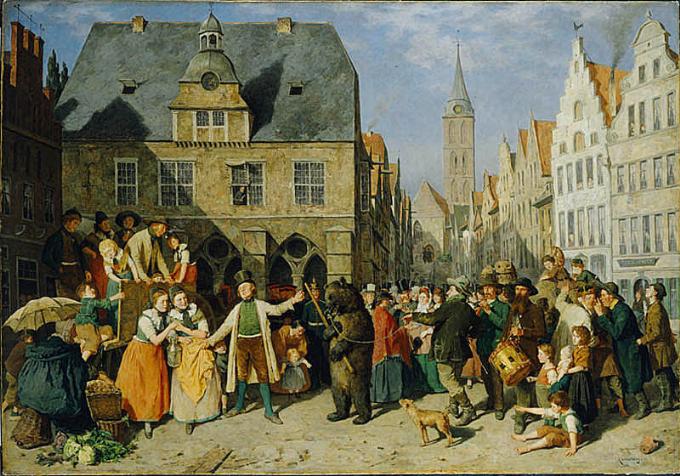Magnificent bears were once captured from distant lands or acquired through shrewd trade.
They were made a spectacle amidst the grandeur of banquets and feasts of medieval and Renaissance Europe. They took center stage, their immense power harnessed for a different, more unusual purpose: entertainment.
These majestic creatures were trained by skilled bearwardens. They were brought into the royal courts to defy their wild nature and perform intricate dances and captivating tricks. Their presence evoked both fascination and fear. They symbolized the allure of the exotic and the display of wealth and power.
The history of dancing bears in European courts reveals a captivating tale of human ingenuity, evolving attitudes toward animals, and the intertwining of culture, entertainment, and cruelty.
There are many layers to their story of acquisition and training, their performances in courts, and the cultural significance they held. Changing perspectives eventually led to their decline. But they left a lasting legacy.

Exotic Animals and Entertainment in Medieval and Renaissance Europe
There were also other remarkable stars of the court, aside from just the dancing bears. There were also apes, horses, dogs, and a myriad of other exotic animals meant to enchant spectators.
These creatures were a common sight across the civilizations of Europe and Asia. They graced the stages of traveling circuses and captivated audiences with their remarkable feats and exotic nature.
The profound connection between humans and bears goes back millennia. Bears held a significant place in human societies. Not only as a source of sustenance and material resources but also as creatures that inspired veneration.
Their imposing stature, occasional upright posture, and omnivorous diet gave rise to legends of kinship and bear cults. This highlights the deep-rooted fascination and reverence humans felt toward them.
However, the practice of keeping bears in captivity as a source of entertainment eventually arose, likely by the second millennium BC in the Middle East. It was also present in Ancient Rome.
By the time of medieval and Renaissance Europe, dancing and performing bears had become a mainstay in royal courts across the continent.
Bear Acquisition and Training
The acquisition and training of bears for dancing performances were marked by a long history of exploitation and cruelty.
In the pursuit, young bears were forcibly separated from their mothers in the wild. They were often taken from the Himalayas, the Middle East, or the jungles of the Indian subcontinent. Tragically, capturing these cubs often resulted in the mother bear losing her life in the process.
Once in captivity, the bears endured a rigorous training regimen that aimed to teach them to dance and perform an array of tricks. The training methods employed were usually harsh and inhumane.
Chains were attached to rings driven through the bears’ noses, and they were compelled to step on red-hot sheets of metal. The bears’ owners would resort to beatings and even tooth extraction to assert control over the powerful creatures.
To ensure their safety during performances, the bears’ claws were tightly trimmed. This allowed them to engage in activities such as giving back massages, imitating celebrities, and delighting audiences with their repertoire of tricks.
Remarkably, Poland and France played notable roles as centers for specialized bear-leading schools.
Under the leadership of appointed Gypsy Kings, talented Gypsies were selected to teach these majestic animals how to dance and perform various tricks. With a team of dedicated Gypsies caring for and training the animals, the bear academies became a bustling institution.
Performances in European Courts
Bear performances in European courts were an enchanting spectacle that captivated audiences with their incredible displays of skill and artistry.
These talented bears underwent a rigorous training process. It even included a dedicated “academic break” from November to February.
They were taught a variety of tricks, from dancing in pairs to pushing baby carriages and more. Once their training was complete, the bears faced a final examination in front of a committee before being sold and sent to perform in various parts of the world.
To create the illusion of dancing, the bear trainers employed clever techniques. They would play music while the bear stood on a hot metal platform, carefully lifting one paw after another to avoid being burned.
Over time, the bears learned to associate music with dancing. Whenever they heard the familiar tunes, they would begin their graceful movements, much to the delight of the audience.
Bear performances were not limited to European courts alone. They appeared throughout the far reaches of the Byzantine Empire as well.
Significance, Symbolism, and Perceptions
Bear dancing in European courts held significant symbolism. The bear, as a powerful and awe-inspiring creature, represented strength and majesty.
Its ability to imitate human actions through dancing and performing tricks fascinated audiences. It showcased the skill and ingenuity of both the bear and its trainers.
In addition to its entertainment value, bear dancing also had symbolic connotations. Bears were not only appreciated for their meat and fur but also revered for their perceived connection to humans.
Perceptions of bear dancing varied among different societies, however. While some viewed it as a form of amusement, others – like twentieth-century Englishmen – began to question the ethics of exploiting these majestic animals for entertainment.
Over time, attitudes toward bear dancing shifted. This led to increased awareness of animal welfare and the recognition that such practices could be cruel.
Changing Attitudes and the Decline of the Practice
Changing attitudes towards the use of bears in performances have led to efforts to ban the practice and provide better living conditions for the bears involved.
Despite these efforts, bear dancing continues in some countries. This continues to perpetuate the suffering of these animals.
Even when bears are rescued from captivity, they often suffer from various physical and mental ailments. This sadly results in premature death.
One significant development in the welfare of dancing bears is the establishment of the Dancing Bears Park in Belitsa, Bulgaria. Managed by Four Paws, an international animal welfare organization, this sanctuary provides a safe haven for bears rescued from captivity.
The historical decline of bear dancing can be attributed to a range of factors, including industrialization, urbanization, and changes in public entertainment.
However, the end of this practice was not altogether a natural evolution but the result of forceful intervention. Bear-leading Roma communities were vulnerable targets for campaigns by animal liberation organizations. This made the abolition of bear dancing more feasible in modern times.
References
“The Cruel History of Dancing and Performing Bears in Europe and Asia.” Daily Mail Online, October 7, 2020. https://www.dailymail.co.uk/news/fb-8809563/The-history-performing-bears.html.
Figes, Orlando. “Dancing in Chains.” The New York Review of Books, July 19, 2018. https://www.nybooks.com/articles/2018/07/19/soviet-nostalgia-dancing-in-chains/.
Tünaydin, Pelin. “Pawing through the History of Bear Dancing in Europe.” Bear Conservation, 2013. http://bearconservation.org.uk/Pawing_through_the_History_of_Bear_Danci.pdf.

